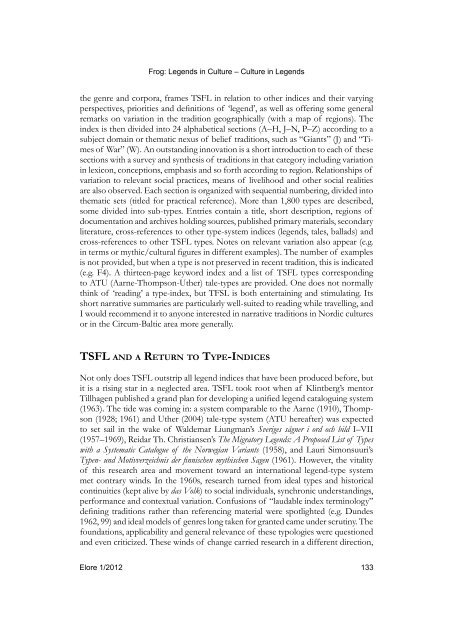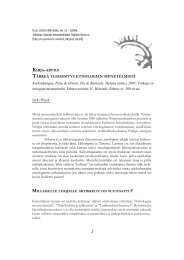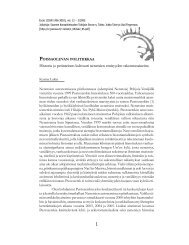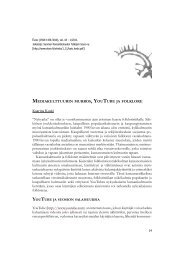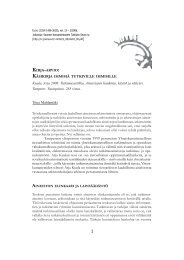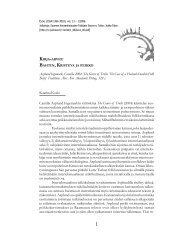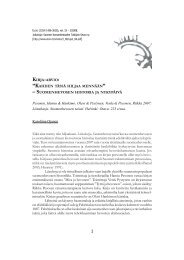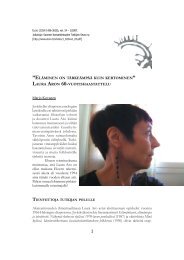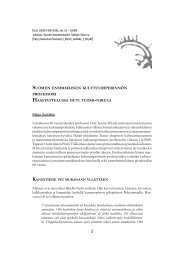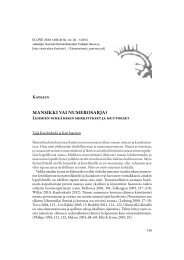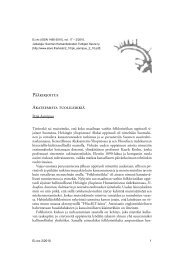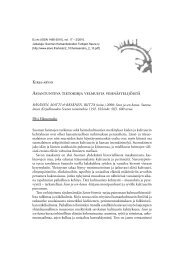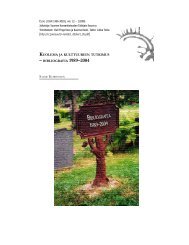Muutoksen tuulia - Elore
Muutoksen tuulia - Elore
Muutoksen tuulia - Elore
Create successful ePaper yourself
Turn your PDF publications into a flip-book with our unique Google optimized e-Paper software.
Frog: Legends in Culture – Culture in Legends<br />
the genre and corpora, frames TSFL in relation to other indices and their varying<br />
perspectives, priorities and definitions of ‘legend’, as well as offering some general<br />
remarks on variation in the tradition geographically (with a map of regions). The<br />
index is then divided into 24 alphabetical sections (A–H, J–N, P–Z) according to a<br />
subject domain or thematic nexus of belief traditions, such as “Giants” (J) and “Times<br />
of War” (W). An outstanding innovation is a short introduction to each of these<br />
sections with a survey and synthesis of traditions in that category including variation<br />
in lexicon, conceptions, emphasis and so forth according to region. Relationships of<br />
variation to relevant social practices, means of livelihood and other social realities<br />
are also observed. Each section is organized with sequential numbering, divided into<br />
thematic sets (titled for practical reference). More than 1,800 types are described,<br />
some divided into sub-types. Entries contain a title, short description, regions of<br />
documentation and archives holding sources, published primary materials, secondary<br />
literature, cross-references to other type-system indices (legends, tales, ballads) and<br />
cross-references to other TSFL types. Notes on relevant variation also appear (e.g.<br />
in terms or mythic/cultural figures in different examples). The number of examples<br />
is not provided, but when a type is not preserved in recent tradition, this is indicated<br />
(e.g. F4). A thirteen-page keyword index and a list of TSFL types corresponding<br />
to ATU (Aarne-Thompson-Uther) tale-types are provided. One does not normally<br />
think of ‘reading’ a type-index, but TFSL is both entertaining and stimulating. Its<br />
short narrative summaries are particularly well-suited to reading while travelling, and<br />
I would recommend it to anyone interested in narrative traditions in Nordic cultures<br />
or in the Circum-Baltic area more generally.<br />
TSFL and a Return to Type-Indices<br />
Not only does TSFL outstrip all legend indices that have been produced before, but<br />
it is a rising star in a neglected area. TSFL took root when af Klintberg’s mentor<br />
Tillhagen published a grand plan for developing a unified legend cataloguing system<br />
(1963). The tide was coming in: a system comparable to the Aarne (1910), Thompson<br />
(1928; 1961) and Uther (2004) tale-type system (ATU hereafter) was expected<br />
to set sail in the wake of Waldemar Liungman’s Sveriges sägner i ord och bild I–VII<br />
(1957–1969), Reidar Th. Christiansen’s The Migratory Legends: A Proposed List of Types<br />
with a Systematic Catalogue of the Norwegian Variants (1958), and Lauri Simonsuuri’s<br />
Typen- und Motivverzeichnis der finnischen mythischen Sagen (1961). However, the vitality<br />
of this research area and movement toward an international legend-type system<br />
met contrary winds. In the 1960s, research turned from ideal types and historical<br />
continuities (kept alive by das Volk) to social individuals, synchronic understandings,<br />
performance and contextual variation. Confusions of “laudable index terminology”<br />
defining traditions rather than referencing material were spotlighted (e.g. Dundes<br />
1962, 99) and ideal models of genres long taken for granted came under scrutiny. The<br />
foundations, applicability and general relevance of these typologies were questioned<br />
and even criticized. These winds of change carried research in a different direction,<br />
<strong>Elore</strong> 1/2012 133


